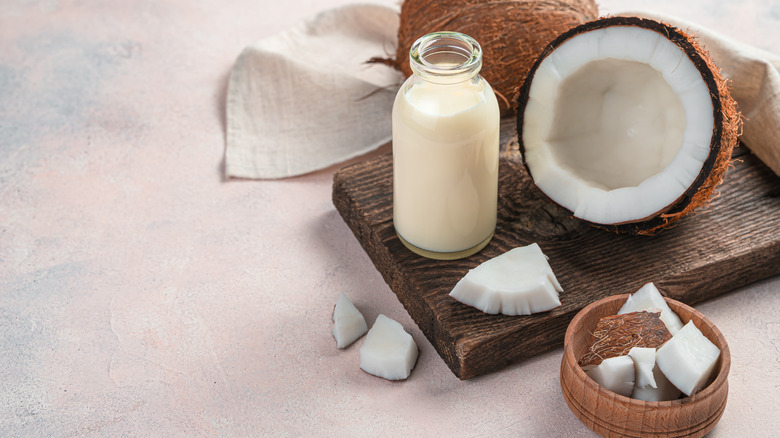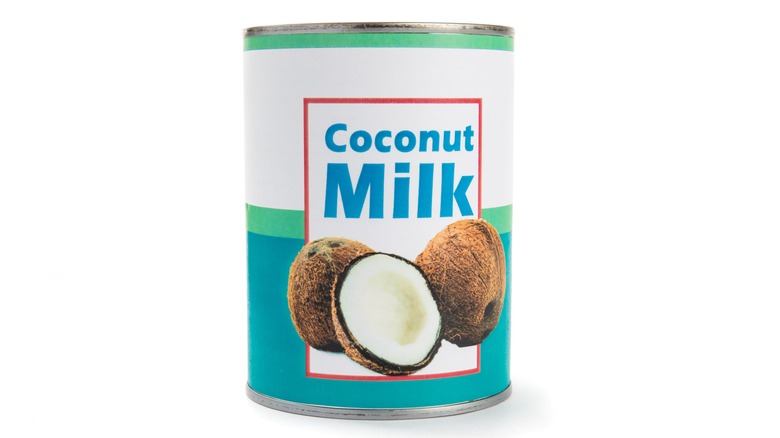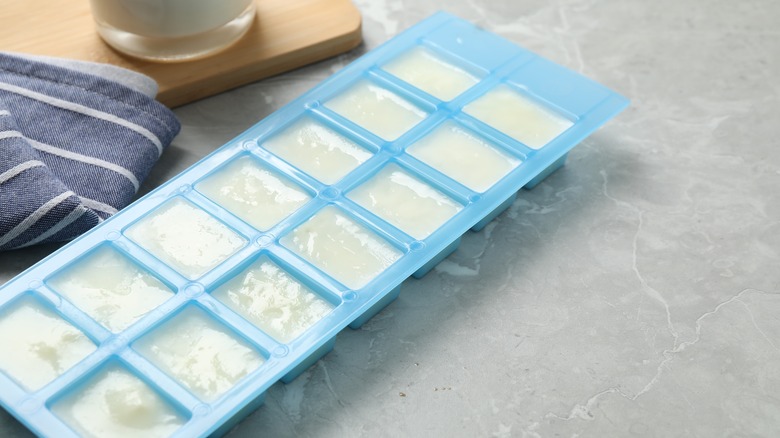How To Store Leftover Canned Coconut Milk So It Won't Taste Like Metal
Life could be so simple. Every dish with coconut milk in it could use the entire can. But, alas. Just when you thought you knew everything you needed to know before adding canned coconut milk to a recipe, those liquid leftovers stared you dead in the eye and dared you to toss a precious commodity down the drain. When plans for the rest of the can are scarce, try a kitchen hack to extend the life of your coconut milk by a month.
Yes, a month instead of a week tops (the typical shelf life for an open can of coconut milk), though it's not just coconut milk that spoils so quickly, of course. The USDA recommends using any canned foods within four days of prying them open, citing both flavor and freshness. The USDA also suggests moving canned contents to a separate storage container, such as plastic or glass. Keeping your leftovers — including coconut milk — in the can from whence they came is a taste faux pas.
While canning can preserve unopened food for years, decades, or even more than a century in the case of some circa-1824 tinned roast veal from Donkin and Hall that ended up in a museum, the buck stops (and the clock starts ticking) once cans are opened. Luckily, there's a way to store canned coconut milk so that it won't pick up any metallic flavors for as long as you decide to keep it around.
Not quite cryogenic, but frozen
When a can opener's blade tears into a food container, its contents can mingle with nearby microorganisms. As a safety side note, cans with deeply dented rims should be banished from the cupboard because of tiny holes the dents can create in the metal. Though often imperceptible to the naked eye, these holes can compromise the can's bacteria shield.
But even with a properly opened can, some people complain of a metallic taste leaching into foods, especially coconut milk. To avoid such a flavor offense, cannily transfer the coconut milk (or any canned food item) to a separate container once opened. For even longer storage, however, skip the fridge in favor of the freezer.
The unsung hero here is your ice cube tray. More than a solution for leftover pesto or lemon juice, ice cube trays handle leftover coconut milk and even coconut cream like a champ.
For best results, pour the milk in after it's been stirred and emulsified. That way, your cubes will be uniform in oil, protein, and water going in, though you might still decide — for texture's sake — to thaw and re-mix them when they come out next, depending on the recipe.
Using your frozen coconut milk
The coconut milk that goes into your tray well-emulsified will still separate when you freeze it. You can use it this way if you'd like. You might even toss the frozen cubes of coconut milk directly into your smoothies. For soups and curries, however, mixing the separated cubes back up once defrosted gives the milk a like-new texture for cooking.
With coconut milk's touted health benefits, including anti-microbial and anti-inflammatory properties, finding ways to make sure you use every drop could be more than just a way to save money on groceries. Where yesterday you tossed an opened can in the fridge to languish and turn like some coconut-rich tycoon, today you can extend a precious ingredient's life like a thrifty food waste superhero. Just make sure you do it quickly after opening. For those with any leftover lactose-free white gold in the fridge now, there's an easy way to tell if that coconut milk has gone bad already.


